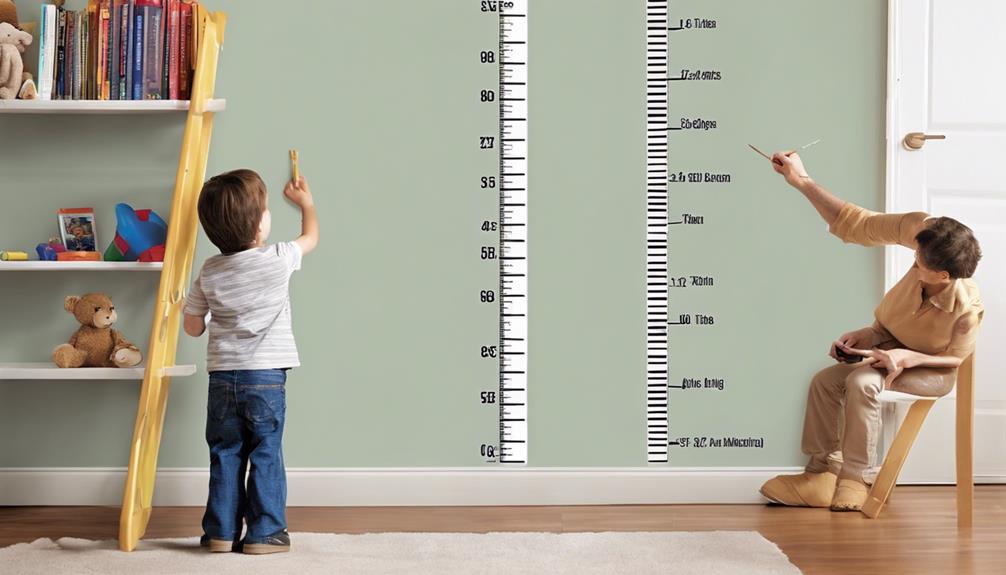As we navigate the complex landscape of children's growth and development, we often ponder the effectiveness of our monitoring strategies. Are we truly equipped to identify the subtle signs that might indicate a need for intervention? Understanding the nuances of growth monitoring and developmental milestones can be pivotal in shaping a child's future well-being.
By exploring the importance of growth tracking, key developmental milestones, tools for assessment, recognizing signs of delay, and strategies for providing developmental support, we can unravel the intricate tapestry of children's growth and development.
Key Takeaways
- Regular growth tracking through programs like Growth Monitoring Program is vital for children's healthy development.
- Monitoring key developmental milestones, including motor skills and language development, aids in early issue identification.
- Utilizing tools like growth charts and standardized assessments ensures accurate monitoring of growth and development.
- Prompt recognition of delays in milestones and timely intervention are essential for providing necessary developmental support.
Importance of Growth Tracking
Tracking children's growth is essential for ensuring their healthy development from birth onward. Monitoring a child's growth, especially their weight gain, is critical for parents and caregivers to understand if the child is progressing as expected for their age. Monthly monitoring visits, such as those in the Growth Monitoring Program (GMP), play an important role in identifying any potential issues early on. By keeping a close eye on a child's growth trajectory, parents can address any concerns promptly, ensuring the child's healthy development.
Regular attendance at monitoring sessions allows parents to track their child's growth over time effectively. It provides an opportunity to detect any deviations from the expected growth patterns and address them promptly. Having a growth chart for each child helps in visually representing their growth and development, making it easier for parents to notice any trends or changes. This proactive approach to monitoring children's growth ensures that any developmental issues can be addressed timely, promoting the overall well-being of the child.
Key Developmental Milestones to Watch

As we focus on observing children's growth and development, it's important to highlight key developmental milestones to watch for in different areas of their progress. In relation to gross motor skills, keep an eye out for milestones like crawling, walking, and running, as these activities showcase the development of large muscle groups and coordination.
Additionally, milestones for fine motor skills involve achievements such as grasping objects, drawing, and eventually writing, indicating the refinement of hand-eye coordination and dexterity.
Language development milestones are vital indicators of a child's progress. Look for milestones like first words, simple sentences, and storytelling abilities, which demonstrate increasing communication skills and vocabulary expansion.
Moreover, social-emotional skills are essential for healthy development. Pay attention to milestones like bonding with caregivers, playing with peers, and showing empathy, as they signify emotional understanding and social interaction capabilities.
To conclude, cognitive abilities milestones, including problem-solving, reasoning, and abstract thinking, are key markers of intellectual growth and development, providing insights into a child's cognitive advancement. Monitoring these developmental milestones is crucial for understanding and supporting a child's overall growth and development.
Tools for Growth Assessment

Growth charts serve as indispensable tools in monitoring children's development and growth progressions, offering valuable insights into their overall well-being. When evaluating a child's growth, various measurements are essential. Weight for age helps evaluate nutritional status and overall health. Head circumference measurements play a vital role in tracking brain development and early detection of abnormalities in infants. Height measurements are important for older children, indicating growth patterns and potential concerns. Regular utilization of standardized tools, such as growth charts and BMI calculations, guarantees accurate monitoring of a child's growth and development. Below is a table summarizing key aspects of growth assessment tools:
| Growth Assessment Tool | Purpose |
|---|---|
| Weight for Age | Evaluating nutritional status |
| Head Circumference | Monitoring brain development |
| Height Measurements | Assessing growth patterns |
Recognizing Signs of Delay

When observing children's development, it's important to be attentive to potential signs of delay in various aspects of their growth and milestones. Delays in developmental milestones like sitting up, crawling, walking, or speaking can be indicative of underlying issues.
It's vital to monitor for signs of delays in social interactions, such as a lack of eye contact or responsiveness to emotions, which could suggest challenges in social development. Additionally, paying attention to fine motor skill delays, like struggling to hold objects or use utensils, and cognitive abilities delays, such as difficulties in problem-solving or memory recall, can provide insights into a child's overall development.
If you notice any significant delays in growth or development milestones, consulting with healthcare providers is essential to address any concerns promptly. Being vigilant and recognizing these signs of delay early on can help in providing the necessary support and interventions to promote a child's healthy growth and development.
Strategies for Developmental Support

To effectively support children's development, early intervention programs should be implemented promptly to address any identified delays. Utilize standardized screening tools at specific ages to detect developmental delays early.
Encourage parental involvement in monitoring and supporting their child's growth, fostering a strong foundation for developmental progress. Collaborate with multidisciplinary teams to provide thorough support, drawing on the expertise of professionals from various fields to tailor interventions to the child's specific needs.
Access to specialized services like therapy and special education is vital for children requiring additional support. By incorporating early intervention programs, involving parents in the process, leveraging standardized screening tools, and working with multidisciplinary teams, children with developmental delays can receive the necessary support to reach their full potential.
Thorough support through these strategies ensures that children facing developmental challenges have the best opportunities for growth and success.
Frequently Asked Questions
What Is the Best Way to Monitor Children's Development?
Monitoring children's development involves tracking height, weight, and head circumference regularly. We use growth charts recommended by organizations like WHO for comparison. Looking for consistent growth trends guarantees healthy progress in physical and cognitive areas.
How Do You Measure Growth and Development of a Child?
We measure a child's growth and development through assessments of weight, height, head circumference, and behavioral milestones. Tailored growth charts and regular check-ups help track progress accurately. Understanding factors like genetics and nutrition is essential for effective monitoring.
How Do You Assess the Growth and Development of a Child?
We assess children's growth and development by tracking weight, height, milestones, and nutrition. Collaboration with healthcare providers guarantees a thorough evaluation. Growth charts and observations help identify deviations for timely interventions, promoting healthy progress in various developmental areas.
Why Do We Monitor Growth and Development?
We monitor growth and development to catch health or nutrition issues early, intervene promptly for any delays, guarantee proper treatments, and gauge progress against growth charts. Tracking milestones helps identify and address health concerns efficiently.
Conclusion
To sum up, monitoring children's growth and development is like tending to a delicate garden, ensuring each plant receives the care and attention it needs to flourish.
By tracking growth, recognizing milestones, utilizing assessment tools, and providing support for any delays, we can nurture children's development effectively.
It's important to be proactive, attentive, and responsive in order to promote best growth and make sure every child reaches their full potential.









